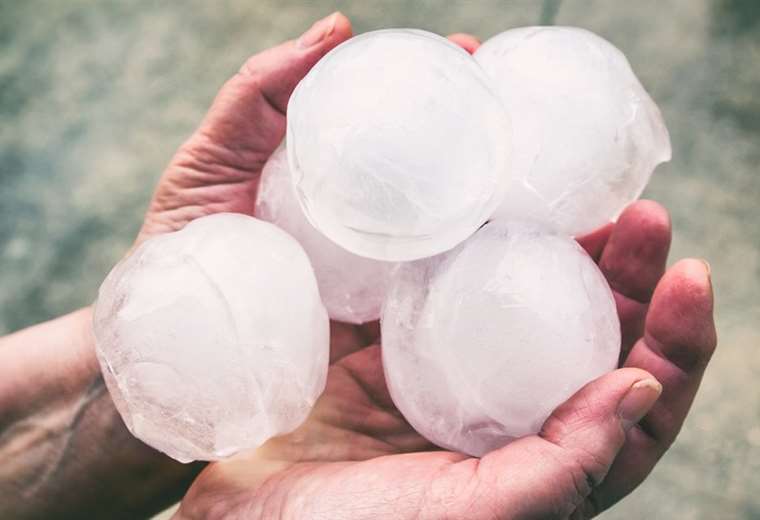September 1, 2022, 8:27 AM
September 1, 2022, 8:27 AM
A ferocious hail storm that hit Catalonia, Spain, on Tuesday afternoon killed a 20-month-old baby from a head injury caused by an ice ball.
Hailstones from the storm – some of which were up to 10 cm in diameter – destroyed windows, roofs and power lines.
The phenomenon that occurred in the province of Girona -which lasted for just over ten minutes- also left dozens of injured.
this artThis article by David Hambling of BBC Future, published in March this year, investigates why hail storms will become a more frequent phenomenon.
On the night of July 21, 2021, hailstones the size of golf balls suddenly fell from the sky in Leicestershire, UK, shattering windows and hitting cars.
While the hailstorm, caused by strong updrafts of clouds high in the atmosphere, was unusual in its severity, it was mild compared to another that hit Calgary, Canada, in June 2020.
And it is that the climate changeattic is altering the pattern of hail storms. In Texas, Colorado and Alabama, in the United States, the record for the largest hailstones was broken in the last three years, with ice balls reaching 16 cm. In 2020 in Tripoli, the capital of Libya, hail of up to 18 cm fell.
But why might global warming be causing an increase in the amount of ice falling from the sky? And is there a limit to the size a stone can reach?
Weight, size and speed
Hail forms when water droplets are carried upwards in a thunderstorm. Updrafts carry them to parts of the atmosphere where the air is cold enough to freeze the droplets.

Moisture in the air collects on the outside of ice droplets as they move through the air, causing hail. grow in layers like an onion.
How fast a hailstone grows depends on the amount of moisture in the air. It will continue to grow until the updraft is no longer strong enough to keep it airborne.
An updraft of 103 km/h supports hail the size of a Golf ballwhile a 27% faster current can create hail the size of baseballs, according to the US National Oceanic and Atmospheric Administration (although, as we’ll see in a moment, the size of a hailstone isn’t always directly related to its weight).
More moist air and more powerful updrafts will bring larger hail. Larger hailstones will often fall closer to the updraft, while smaller hailstones will fall farther away, blown there by crosswinds.
trigger
Destructive storms that produce hail larger than 25mm in diameter require a specific set of conditions, says Julian Brimelow, a physical scientist at Environment and Climate Change Canada, a Canadian government department that has studied how climate change affects formation. of the hail.

They require sufficient moisture, powerful updrafts, and a “trigger factor”usually a weather front.
This is why severe hailstorms are generally confined to particular regions, such as the Great Plains in the US and the Gold Coast in Australia.
Typically, these regions have cool, dry air in the upper atmosphere above warm, moist surface air. This unstable situation causes strong updrafts and the formation of thunderstorms.
These places are particularly prone to a type of thunderstorm known as supercells (or supercells), which can generate very large hail due to the powerful rotating updrafts they create.
But as climate change alters the temperature of Earth’s atmosphere, it also changes the amount of moisture in the air. Warmer air can hold more water vapor, while higher temperatures also mean more water evaporates from Earth’s surface.
This is expected to lead to heavier rain and more extreme storms in some parts of the world.
“As the planet continues to warm, the areas conducive to hail storms are likely to change,” says Brimelow. “An area now where sufficient moisture is a limiting factor may become wetter and consequently the frequency of hail storms may increase.”
higher intensity
A combination of observations of changes already occurring and climate models has led researchers to conclude that hail storms will become more frequent in Australia and Europe, but will decrease in East Asia and North America.
But they also found that hail storms will generally become more intense.

And while hail storms may become less frequent in North America, hailstones are likely to be bigger, according to a separate study by Brimelow and colleagues that looked at how hail conditions in North America might change in a warmer world.
One reason is that the height at which hailstones begin to melt as they fall will increase, so small hailstones will melt and turn into rain before they hit the ground, but larger stones will pass too quickly through the ground. through the area warm enough to melt.
“In fact, we’ve already seen evidence of this, with hail data from France indicating a change in hail size distribution,” says Brimelow.
Hail pads are blocks of soft material placed outside during storms that deform when impacted by hail, providing a record of the size and amount of hail in the area.
“Fewer days with small hail have been observed with warming, but there have been more days with larger hail.”
Density
But pinpointing exactly which areas will see the most hail damage is difficult, Brimelow says.

The temperature and moisture level in the air in which hail forms can influence its density.
In very cold air, the water freezes as soon as it hits the hail, but this can create a lot of air and mix with the ice. If the water freezes more slowly—perhaps because the air is warmer or the amount of moisture in the air is high, meaning it doesn’t all freeze instantly—the air bubbles have time to escape.
This causes clear ice to form that tends to be denser. Small hailstones are only half as dense as pure ice, as they have a lot of air mixed in with them and tend to move rapidly through the atmosphere before falling back.
The largest hailstones are often made up of a complex mix of ice sheets that form as they move in the air column.
Looking at a cross section of the ice can reveal a lot about how it formed, while the lobe-like structures on the outside of the hail also provide clues as to how it might have been spinning during the storm.
Size
The density of the hail also affects its size. The heavier it is, the more likely it is to topple over due to an updraft. And it will also fall faster, because the bigger a hail is, the less drag it experiences per unit of weight.

The heaviest hailstone ever recorded fell in the district of Gopalganj of Bangladesh in 1986with a weight of 1.02kg. The storm killed 40 people and injured 400 others, according to reports at the time, but later reports suggest that as many as 92 people may have lost their lives from this incident.
But how big can a hailstone get?
the maximum possible
Matthew Kumjian, a meteorologist at Pennsylvania State University in the US, estimates that the largest hail could measure 27cm wide (“the size of a bowling ball”), according to simulation models.
Nothing that big has been recorded yet, however, and he says he’s working with some colleagues to refine the estimate. While 27 cm is on the higher end of the estimates, a hailstone of that size would be very irregular in shape.
But he explains that ingredients needed to create such a large hail (strong updrafts, lots of supercooled liquid water, and lots of time to travel in cold air) they currently exist.
“The strong ‘supercell’ storms that produce the world’s largest hailstones already have many of these ingredients together, so the strongest of these storms today is probably capable of producing a supergiant hailstone.”
Now you can receive notifications from BBC World. Download the new version of our app and activate it so you don’t miss out on our best content.
















